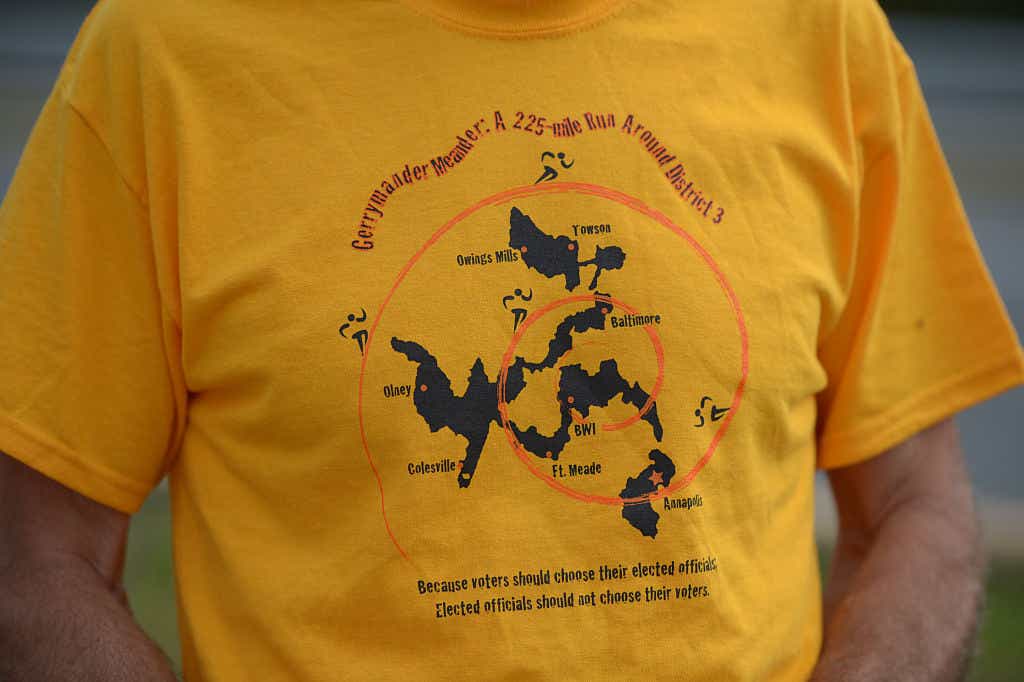A brief history of how gerrymandering rigs elections for both parties.
Have you ever wondered why the district where you vote bears a striking resemblance to a duck, a snake, or an oil stain? Well, these lopsided shapes aren’t entirely a coincidence.
It has to do with what’s known as redistricting — the once-a-decade process that uses the U.S. Census to draw lines that define the political districts from which public officials are elected. When conducted fairly, it’s a routine procedure that accurately represents population changes and racial diversity, helping lawmakers allocate the necessary representation and local funds to support vital social programs like food assistance. But when politicians use redistricting to manipulate the outcome of elections, it’s called gerrymandering — which experts warn undermines democracy and stifles voters’ voices. And, with the rise of technology, it’s only expected to get worse: While gerrymanderers previously had to draw maps by hand, now they can use algorithms to generate thousands of options and game redistricting with almost surgical precision.
“It’s deeply undemocratic,” says Kareem Crayton, who’s a senior director for voting and representation at the nonprofit Brennan Center for Justice. “And it challenges the clear line of accountability for lawmakers.”
Despite its very real impacts on everyday Americans, most people aren’t aware of the map-drawing process or how it works in their own state. In fact, 85 percent of voters say they have heard little or nothing at all about this legislative action in their state, according to a survey last year by the nonpartisan Pew Research Center. We took a deep dive into what you should know about this complicated process — and how it affects the weight your vote carries.
What is gerrymandering?
Gerrymandering occurs when district lines are drawn to give an advantage to a specific political party or group of people. The term was first coined in 1812 after Massachusetts Gov. Elbridge Gerry approved an oddly shaped state Senate district thought to resemble a salamander that was drawn to favor his own party, then called the Democratic-Republicans. In response, the Federalist newspaper the Boston Gazette published a satirical cartoon of the new district resembling the creature, which it dubbed “The Gerry-mander,” and the rest is history.
Over the last two centuries, the quickest way to spot a gerrymandered map of congressional districts has been to look at their shapes. For instance, Maryland’s 3rd Congressional District, now held by Democratic Rep. John Sarbanes, is widely regarded as one of the most gerrymandered in the nation, roping together voters across Silver Spring, northern Montgomery County, Columbia, Annapolis, the city of Baltimore, and Baltimore County. U.S. Circuit Judge Paul V. Niemeyer once likened it to a “broken-winged pterodactyl, lying prostrate across the center of the state,” while others have compared it to a blood splatter at a crime scene.

But the reality now is you can’t always tell whether lines are being manipulated just by looking at a congressional map. David Wasserman, who’s an election analyst with the nonpartisan Cook Political Report, points to Florida as a prime example of this phenomenon.
“Florida may be a Republican-leaning state, but it doesn’t lean Republican by that much,” he tells Katie Couric Media. “What Republicans did was very artfully split Democratic areas in a way that allows their party to have an exaggerated margin in the delegation.”
How does gerrymandering work?
One common method is for the majority party to split groups of people with similar characteristics, like party affiliation or race, across multiple districts, resembling the shape of a pizza slice. The voters who are scattered to the winds are often affiliated with the opposite party of the one in power, and with their numbers divided, these groups struggle to elect their preferred candidates in any of the districts.
Another common technique is packing, where the state’s leading party crams certain groups, such as minorities, into as few districts as possible. That almost guarantees the opposition will win those districts, but this packing limits their victories, making it difficult, if not impossible, to win elections statewide. This is how many states, primarily in the South, tried to limit the influence of Black voters over several decades before the introduction of the Voting Rights Act in 1965, but it continues to be used to this day.
Austin, Texas, is a good example of this. After decades of cracking the city apart, the Democratic vote there was getting too big to be diluted by surrounding rural areas, so the Republican-led state legislature drew a brand-new 37th district to lump Democrats into, which helped preserve the GOP’s majority in surrounding districts. “That moved a lot of the surrounding Republican seats to safer ground,” Wasserman says.
Who political party does the most gerrymandering?
The reality is both parties have been accused of gerrymandering — and faced legal action over it. Democrats are most concerned about potential Republican gerrymandering in Ohio, Texas, Florida, Georgia, and North Carolina. Meanwhile, Republicans are on guard for Democratic gerrymandering in Illinois, Oregon, and Maryland.
New York, in particular, was taken to court in a GOP-led effort over gerrymandered lines drawn in 2022 that would have favored Democrats in 22 of the state’s 26 congressional districts. But those were ultimately thrown out last year after it was revealed that the lawmakers drew the lines themselves instead of tasking an independent redistricting commission, as required by law.
“Democrats have been taken to court on gerrymandering homes as in New York, while Republicans have also been taken to court in places like Ohio,” Crayton tells Katie Couric Media. “The real challenge is whether or not courts are going to dutifully and consistently apply the rules.”
But Republicans have more power in state legislatures and governorships across the country. The GOP has complete control over the redistricting process in at least 20 states, compared to Democrats in 10 states. That gives Republicans unrestricted power to draw 187 House districts, and Democrats 75.
Is gerrymandering legal?
The short answer is, it depends. In 2019, the Supreme Court ruled in Rucho v. Common Cause that the federal courts have no authority in blocking this partisan strategy on the state level. “Partisan gerrymandering claims present political questions beyond the reach of the federal courts,” the decision states.
That said, the court left intact parts of the Voting Rights Act of 1965 that prohibit racial or ethnic gerrymandering. If there’s a question of this happening in a certain area and legal action is taken, a judge will typically assess how geographically logical the districts are, to make sure they aren’t designed to disenfranchise people.
We saw this most recently in Alabama, where a group of voters and civil rights organizations sued Republican leaders, including Secretary of State John Merrill, over unfairly distributing Black voters in the state. The case went all the way up to the Supreme Court, and in a surprise 5-4 decision, justices ruled that the state’s Republican-drawn congressional map violated Black voters’ rights. As a result, lawmakers will have to redraw the maps.
While specific timing is still up in the air, this process is expected to happen before the 2024 election, potentially giving Democrats a second congressional seat in the state. Now, experts say this move could prove to be a road map for other gerrymandering cases.
“This case opens up to review gerrymandering cases by SCOTUS, and in that sense, it’s a very important case,” says James Brosnahan, a former trial lawyer who has argued similar cases in front of the California Supreme Court. “It should not be limited to questions of race — in fact, the decision makes that unlikely. But many forms of gerrymandering should be looked at.”
Is there room for reform?
One thing most states have in common when it comes to map drawing is that it’s largely done behind closed doors.
For instance, Wisconsin’s district lines were drawn at a law firm linked to the Republican Party, and vetted by the Republican National Committee before the public was allowed to see them, according to a report by ProPublica. Other states are guilty of this, too. In Texas, the GOP-led state legislature turned to a Republican redistricting operative Adam Foltz in a process that drew condemnation from federal judges who called it “needlessly secret.” Even states like New York and Colorado that do engage in a more open process for redistricting, like holding public forums and town halls, don’t always take public opinion into account.
“When you’re trying to pass a gerrymander, a long process is your enemy, because the more opportunity there is for members of the public or critics in your own party who don’t like an element of a map to jump on it, the lesser chance it has of passing,” says Wasserman. “So, typically, aggressive gerrymanders are proposed at the last minute and adopted quickly.”
A few, mostly Democratic-led, states have taken steps toward reform. Wasserman says California, Colorado, and Michigan have all successfully passed some kind of reform on redistricting to discourage gerrymandering. But he adds that for other states, like New York and Utah, the move to improve redistricting has been “purely ceremonial.”
“Those reforms were essentially designed to fail,” he tells us. “Voters passed those redistricting reforms, but they were watered down to the point that a partisan legislature could override it.”
This is why some advocates are calling for federal reform – namely the passage of The Freedom to Vote Act, which would ban partisan gerrymandering and make it easier for voters to challenge gerrymandered maps in court. So far the legislation has passed in the House and has been introduced in the Senate by Democratic Sen. Amy Klobuchar.
“Voting is fundamental to our democracy,” Crayton says. “The rules governing voting have to matter too.”








